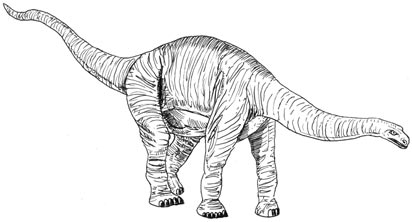Very Rare Dinosaur Bone Discovered in Gloucestershire Quarry
Cotswold Water Park near Cirencester, Gloucestershire has proved a happy hunting ground for one hard working palaeontologist who has been able to piece together a leg bone from a huge Jurassic sauropod. The bone may represent a new species of long-necked dinosaur, but for the time being this specimen has been classified as a Cetiosauriscus. Finding the fossilised bones of Middle Jurassic sauropods is a red-letter day for any palaeontologist, as there are few examples of European Middle Jurassic sauropods known from the fossil record.
Cetiosauriscus Leg Bone
Commenting on this find, Dr Neville Hollingsworth stated that the creature may have been up to 20 metres long and would have resembled a Diplodocus, a more famous long-necked dinosaur known from the Late Jurassic of North America.
An Illustration of Cetiosauriscus

Picture credit: Everything Dinosaur
Cetiosauriscus was originally formerly named and described by the famous German palaeontologists Friedrich von Huene in 1927. The holotype (the specimen upon which the original description of Cetiosauriscus is based), consists of several back bones. Some fragmentary sauropod fossils found on the Isle of Wight may have belonged to diplodocoids, it has been speculated that some of these too, may be ascribed to Cetiosauriscus.
Sifting Through Tonnes of Clay
Dr Hollingsworth took six months to sift through the tonnes of muddy clay at the water park to retrieve all the pieces of fossil bone he could. No other bones have been found, but the painstaking work of Dr Hollingsworth has enabled the 1.4-metre-long bone to be recovered, prepared and made ready for display. The site in the quarry was being refurbished and the area where the fossil pieces were recovered is now flooded.
The fossils were found in Oxford clay a strata associated with marine deposits, so what is a 20 metre long, land-living dinosaur doing fossilised in a marine deposit? The answer is simple, either the animal or its carcase was washed out to sea, perhaps in a flash flood. At first the corpse would have been buoyant, kept afloat by the gases inside the huge body, but after a while the carcase would have ruptured, possibly as a result of the scavenging of sea creatures such as ichthyosaurs and the carcase broken up and scattered.
Explaining why only one bone has been able to be pieced together, Dr Hollingsworth said:
“The rest of the dinosaur is missing, presumed eaten”.
He went on to add:
“There was a point when I wondered if I would recover all the pieces in time. Although it took me over a week to get everything out of the ground it was worth it for such an exciting find”.
The strata in which the fossil was found has been dated to around 168 million years ago (Bajocian faunal stage). Although much of Europe was covered by a shallow sea, this large herbivore would have shared its world with formidable hunters such as Megalosaurus and possibly animals like Eustreptospondylus. The single skeleton of Eustreptospondylus, one of the most complete theropods ever found in Europe seems to have shared the fate of this sauropod. The fossilised skeleton of Eustreptospondylus was also found in marine clays. It is likely that the animal died on land and the carcase washed out to sea where it eventually sank to the bottom and was covered in fine sediment.
Megalosaurus and other Jurassic theropod models: CollectA Age of Dinosaurs Models and Figures.






Hi!
How long is the femur (in mm)?
Thank you,
Regards
Approximately 1400 mm